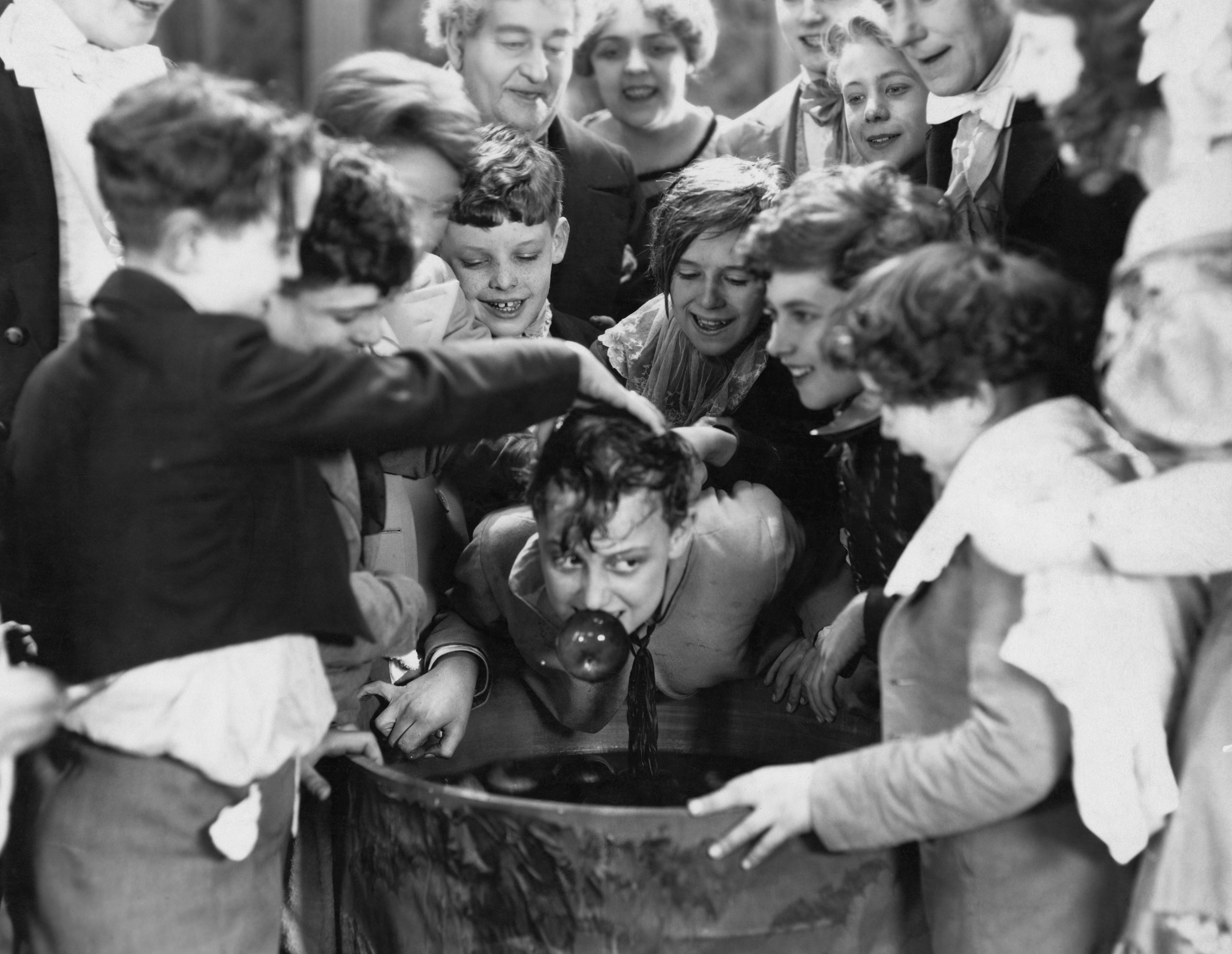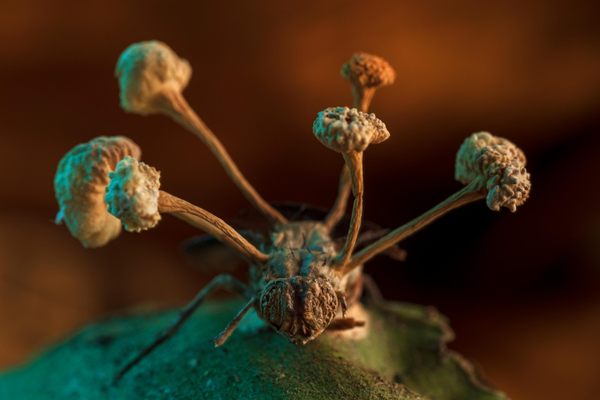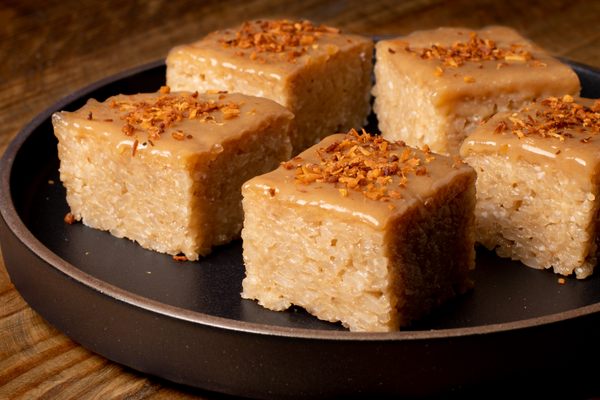The Forgotten Halloween Games That Predict Who You’ll Marry—And When You’ll Die
How to use produce to divine the future, on one night only.


If sticking your face in a barrel filled with cold water and trying to grab an apple with your mouth seems a touch sadistic for a casual game, then you’re really not going to like its sister pagan ritual. It’s sometimes called “snap-apple,” and like bobbing for apples, it comes from a pantheon of mostly forgotten All Hallows’ Eve traditions from the British Isles.
In snap apple, the goal is still to grip an apple in your mouth, no hands allowed. But in this game, the apple is attached to one end of a stick. On the other end, there’s a lit candle. The stick is hung from the ceiling by a rope and set spinning. The player tries for the apple. Any mangled attempt, too slow, too fast, too aggressive, not aggressive enough, can result in a burning candle in the face.
In America today, Halloween is most often associated with pumpkins and candy. For centuries in the British Isles, though, this eerie night was linked with apples, nuts, and cabbage, all of which were given secret powers. And like snap apple, the games played with these foods had much more dramatic stakes than the ones we play today. The risk wasn’t just about getting physically burnt, though.
All Hallows’ Eve is a time when the veil between the world of the living and dead is thinner than usual, and these forgotten rituals banked on that closeness to predict the future—you could find out who you might marry or whether it’d never happened for you, if you’d be a widow, or when you might die.

Among all the food traditions of Halloween, apples appear most often. There are loose theories for why apples are so special on this day. They’ve long been thought to have an uncanny magic: in Welsh folklore, for instance, they carry a whiff of immortality. In the Book of Hallowe’en, an early 20th century study of October 31 traditions, Ruth Edna Kelley writes that apples came to Halloween through the colonizing Romans, who linked their fall apple festival with the Celtic Samhain.
In the 20th century, games like snap apple and bobbing for apples were seen as diversions, but earlier they were more serious. Consider that in Scotland, bobbing for apples is sometimes called dooking or douking for apples, the same word used to describe dunking a women in water to test if she might be a witch. Bobbing for apples, or “snapping” one suspended on the ceiling from a string (a safer version of snap apple) could reveal the future of your love life: in one version, if you got the apple first, you’d have happy love—or, in another, you’d be the first married.
Apple games could also make matches, or predict whether a person would have a good or bad love. Sometimes the apples would be labeled or marked by young men and women before they were put in a tub of water: the person who caught your apple could be your mate. In another version of snap apple, a hoop is suspended from the ceiling, and different treats and tricks, including cake, candies, bread, apples, and peppers, are stationed along its rim. The one a player caught with their teeth would foretell the nature of their love—would it be sweet, spicy, too hot? Would it nourish or burn them?
There are other ways, too, to coax an apple into telling the future on Halloween. You could peel it all in one strip and throw that peel over your shoulder: if it stayed in one piece, it would form the initial of a future lover. Or you could take an apple to a mirror. Shine a candle in the mirror and eat the apple, and you would see your future husband over your shoulder. In one version of the tradition, the apple gets cut into nine pieces, and it’s only after the eighth is eaten that the lover appears, asking for the ninth.

Nuts could also tell the future, and in some places, Halloween was called “nutcrack night” or the “sacrifice of nuts.” If a man brought a woman some walnuts, it would mean he was her true love. But it was also possible to use nuts to see the future of a love. Nuts would be named and set by the fire to see how they burned. If they roasted slowly, together, that would promise a good, strong love. If they crackled and popped and jumped, it was a bad sign.
A girl could test out different suitors this way—the nuts could give a hint to how the relationship might go. Kelley saw a sinister shadow in this: “Who sees in the nuts thrown into the fire, turning in the heat, blazing and growing black, the writhing victim of an old-time sacrifice to an idol?” she wrote.
If none of these fortune telling methods went your way, you could still resort to cabbage. One tradition involved pulling kale stalks from a field: the nature of the stalk, its weight, length, girth, and taste, would hint at one’s future spouse. If the roots still had plenty of earth hanging on them, that could augur a hearty dowry. If you were a woman, you could also steal a cabbage and see who you meet on the way home to find out who your future husband might be. In Ireland and Newfoundland, cabbage and potatoes together, a dish called colcannon, would have a ring or button hidden in it, and whoever found the ring could expect to be married soon. The button was less lucky—it would mean you’d never marry.
If colcannon isn’t appealing, cake is another alternative. Some people would bake a ring and nut into the cake—the finder of the nut would be a widow or widower. In another version, the cake had a coin, a sloe berry and a bit of wood baked in. The coin meant wealth, the sloe meant you’d outlive all your friends and the wood meant you’d die within the year. There were other Halloween augurs, too, that could foretell death: like snap apple, these games were not kidding around. Compared to the risk of having your death foretold, getting a little wet while bobbing for apples seems pretty tame.
Gastro Obscura covers the world’s most wondrous food and drink.
Sign up for our email, delivered twice a week.

























Follow us on Twitter to get the latest on the world's hidden wonders.
Like us on Facebook to get the latest on the world's hidden wonders.
Follow us on Twitter Like us on Facebook